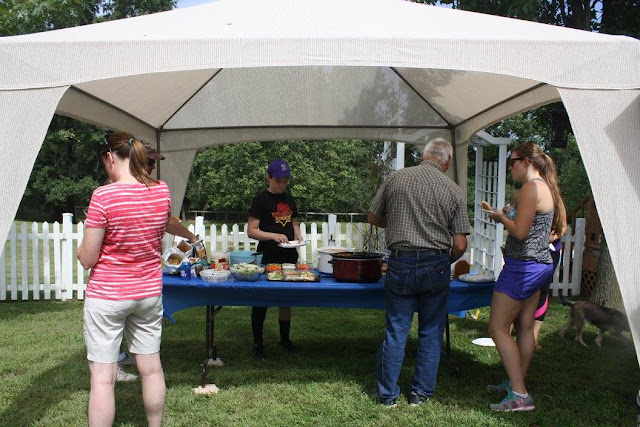The grapes are harvested by using small pruning shears to snip the top of the grape cluster from the vine. For vigorous vined varietals with lots of foliage, teams of two work on opposite sides of the trellis to assist with holding up the foliage, snipping, and locating clusters of hiding grapes.
Vines are covered with netting in late July to keep the birds and wildlife from consuming the crop.
In mid-August, the grapes are being checked for brix (sugar level) and acidity levels using a refractometer. The Ph is tested to determine acidity. As the sugar and acidity levels approach the desired balance, the grapes are checked more often. Each grape has its own targeted brix level which is determined by the type of wine that will be made. The harvest date is set, the grapes are uncovered, the totes are set out and tables with water, pruning shears, and other essentials are prepared.
Guests are greeted with enthusiasm and appreciation! People come and go during the harvest party. Lunch is served. Gifts of grapes and wine are offered as appreciation for their time and talents.
The full totes are loaded and taken to the processing room where they are weighed and the data is logged. The totes are emptied into the crusher/de-stemmer where the grapes are crushed by pulling the juices and meat apart from the stems. These are discarded into separate containers. The juice is poured into fermentation vessels or a wine press.
Climate and weather conditions for the year influences when the grapes are ready to be harvested. Moisture, heat, humidity, wind, sunlight... all impact the quantity and quality of the grapes for the season. These play a role in the number of grapes, size of the clusters, and the timetable for the harvest. Sunlight, for example, reduces bacteria, mold, and fungus and helps keep these from growing on the grapes. Overcast days with excess humidity creates an optimal environment for these pathogens. Missouri winemakers have their hands full when it comes to humidity!
Twin Meadows uses their grapes to make blushes, full-bodied red, dessert wines, spirits, and juice. The grapes are also used to make jelly, sauces, pies, and table grapes. Check out their website to see their selections here.
I paired Twin Meadow's Caramel Apple wine with a shrimp boil. We made a delicious Sangria-type wine and man, it was refreshing and delicious. With fall harvest foods like corn-on-the-cob and potatoes with fresh shrimp from the Gulf, this was a wonderful harvest meal.

Apple Wine Sangria
Ingredients:
- 1 bottle Twin Meadows Carmel Apple wine
- 8 c apple cider
- 1 c "43"
- 2 crisp apples, chopped
Instructions:
- Mix together all ingredients.
- Store in the refrigerator until served.
- Serve on ice with an apple slice.
Notes:
Calories
108.19Fat (grams)
1.40Sat. Fat (grams)
0.16Carbs (grams)
22.70Fiber (grams)
0.90Net carbs
21.80Sugar (grams)
17.71Protein (grams)
0.50Sodium (milligrams)
44.19Cholesterol (grams)
0.03- Our Good Life is celebrating Harvest Time at Twin Meadows Winery.
- The Quirky Cork discusses The Art of the Harvest.
- Asian Test Kitchen pours French Style Wines by the Sea from Windy Oaks (With 3 Fab Food Pairings)
- Somm's Table posts A Harvest at Forlorn Hope & Juicy Lucies.
- Always Ravenous hosts a Fall Harvest Dinner with Wine Pairings.
- Crushed Grape Chronicles highlights Regenerative Agriculture at Tablas Creek - A Meaningful Way to Farm.
- Culinary Adventures with Camilla shines the spotlight on Donkey & Goat: The Brandts Bring Natural Farming Philosophies Into the Cellar.































A great recap of a harvest. It is such a wonderful time of the year. Looks like a fun pairing.
ReplyDeleteThis is a really good breakdown of what happens at harvest. Also, that shrimp boil looks fab.
ReplyDeleteWhat a wonderful way to enjoy harvest. Shrimp boil and sangria sound like a wonderful way to spend an evening in the late summer!
ReplyDeleteI have some fond memories of Chambourcin wines! I know grape harvesting is incredibly difficult work but your pictures make it look like such a jovial and fun event!
ReplyDelete